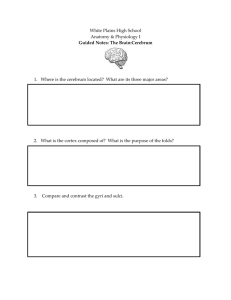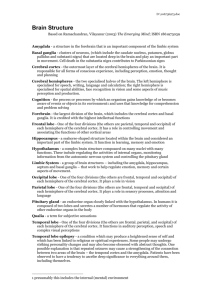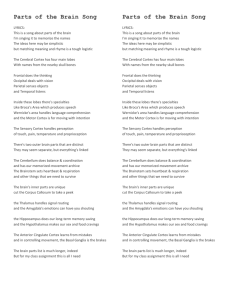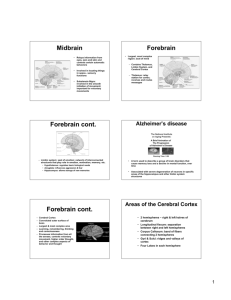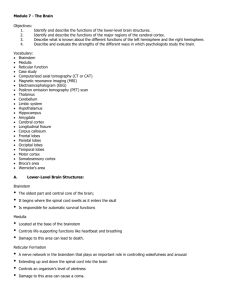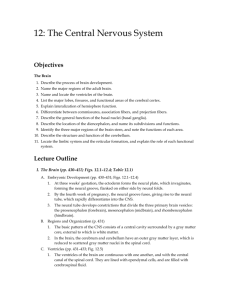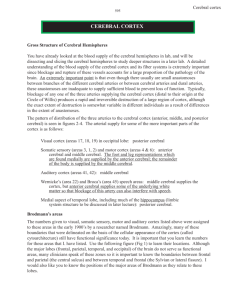Summary of the Major Brain Structures Brain Stem Cerebellum
advertisement
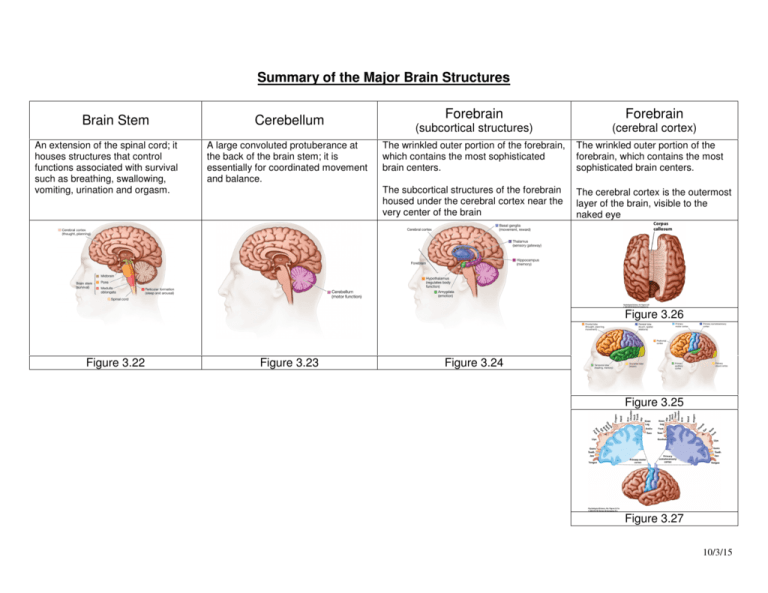
Summary of the Major Brain Structures Brain Stem An extension of the spinal cord; it houses structures that control functions associated with survival such as breathing, swallowing, vomiting, urination and orgasm. Cerebellum A large convoluted protuberance at the back of the brain stem; it is essentially for coordinated movement and balance. Forebrain Forebrain (subcortical structures) (cerebral cortex) The wrinkled outer portion of the forebrain, which contains the most sophisticated brain centers. The wrinkled outer portion of the forebrain, which contains the most sophisticated brain centers. The subcortical structures of the forebrain housed under the cerebral cortex near the very center of the brain The cerebral cortex is the outermost layer of the brain, visible to the naked eye Figure 3.26 Figure 3.22 Figure 3.23 Figure 3.24 Figure 3.25 Figure 3.27 10/3/15 Brain stem Cerebellum Forebrain (subcortical) Forebrain (Cerebral Cortex) • Medulla oblongata Controls vital autonomic life functions such as breathing, circulation, digestion and heart rate. The medulla also controls a number of vital reflexes, such as swallowing, coughing, vomiting and sneezing. • Pons A hindbrain structure that relays information from the cerebellum to the rest of the brain. information. • Midbrain • Reticular Formation A network of nerve fibers located in the center of the medulla that helps regulate attention, arousal and sleep. It seems to help filter out unimportant sensory • Cerebellum A large convoluted protuberance at the back of the brain stem; it is essentially for coordinated movement and balance. • Thalamus The gateway to the brain; it receives almost all incoming sensory information before that information reaches the cortex (smell doesn’t go through the thalamus) • Hypothalamus (under thalamus) A brain structure that is involved in the regulation of bodily functions, including body temperature, blood pressure, and blood glucose levels; it also influences our basic motivational behaviors including thirst, hunger, aggression and lust. • Hippocampus: A brain structure that is associated with the formation of memories (memories are NOT located in the hippocampus) • Amygdala: A brain structure that serves a vital role in our learning to associate things with emotional responses and in processing emotional information. • Basal ganglia: A system of subcortical structures that are important for the production of planned movement. • Cerebral cortex The outer layer of brain tissue which forms the convoluted surface of the brain. • Corpus callosum A massive bridge of millions of axons, connects the hemispheres and allows information to flow between them. • Occipital lobe Regions of the cerebral cortex—at the back of the brain—important for vision. • Parietal lobe Regions of the cerebral cortex—in front of the occipital lobes and behind the frontal lobes—important for the ense of touch and for conceptualizing the spatial layout of the environment. o Somatasensory cortex • Temporal lobe Regions of the cerebral cortex—below the parietal lobes and in front of the occipital lobes—imprtant for processing auditory information, for memory, and for object and face perception. o Wernicke’s area • Frontal lobe Regions of the cerebral cortex—at the front of the brain—important for movement and higher-level psychological processes associated with the prefrontal cortex o Broca’s area o Motor Cortex o Prefrontal cortex: the frontmost portion of the frontal lobes, especially prominent in humans; important for attention, working memory, decision making, appropriate social behavior, and personality • Association areas Areas of the cerebral cortex that are composed of neurons that help provide sense and meaning to information registered in the cortex. 10/3/15


